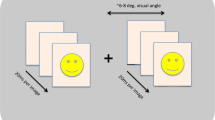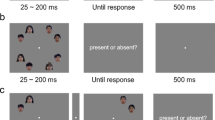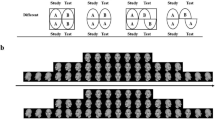Abstract
This research examined the effects of massed versus distributed exposure and imaging of faces, and the effects of changing the study-to-test view on subsequent recognition performance. The massed procedure consisted of individual faces exposed once for 6 s, followed by a 30 s off period. The distributed procedure consisted of faces exposed three times for 2 s, followed by a 10 s off period after each exposure. During the off periods, groups of participants either imaged the previous face, imaged another face, or performed an irrelevant letter-search task. Results showed that distributed exposure and post-exposure imaging of target faces facilitated recognition, but these effects primarily occurred when the same facial view was given at both study and test. Recognition diminished when the target was presented in a different view at test, but when combined with distributed presentation and target imaging, performance was enhanced. Implications for suspect identification and recognition of other kinds of complex visual stimuli are discussed.
Similar content being viewed by others
References
Allport, D.A., Antonis, B., & Reynolds, P. (1972). On division of attention: A disproof of the single channel hypothesis.Quarterly Journal of Experimental Psychology, 24, 225–235.
Bruce, V. (1988).Recognising faces. East Sussex, UK: Lawrence Erlbaum.
Friedman, A., & Polson, M.C. (1981). Hemispheres as independent resource systems: Limited-capacity processing and cerebral specialization.Journal of Experimental Psychology: Human Perception and Performance, 7, 1031–1058.
Graefe, T. M., & Watkins, M. J. (1980). Picture rehearsal: An effect of selectively attending to pictures no longer in view.Journal of Experimental Psychology: Human Learning and Memory, 6, 156–162.
Herman, P. G., & Hessel, S. J. (1975). Accuracy and its relationship to experience in the interpretation of chest radiographs.Investigative Radiology, 10, 62–67.
Kottoor, T. M. (1989). Recognition of faces by adults.Psychological Studies, 34, 102–105.
Landauer, T. K., & Ross, B. H. (1977). Can simple instructions to use spaced practice improve ability to remeber a fact?: An experimental test using telephone numbers.Bulletin of the Psychonomic Society, 10, 215–218.
McKelvie, S. J. (1983). Effects of lateral reversal on recognition memory for photographs of faces.British Journal of Psychology, 74, 391–407.
Perruchet, P. (1989). The effect of practice on explicit and implicit memory.British Journal of Psychology, 80, 113–130.
Rea, C. P., & Modigliani, V. (1988). Educational implications of the spacing effect. In M. M. Gruneberg, P. E. Morris, & R. N. Sykes (Eds.),Practical aspects of memory: Current research and issues (Vol. 1, pp. 402–406). Chichester, UK: John Wiley & Sons.
Schooler, J. W., & Engstler-Schooler, T. Y. (1990). Verbal overshadowing of visual memories: Some things are better left unsaid.Cognitive Psychology, 22, 36–71.
Sporer, S. L. (1988). Long-term improvement of facial recognition through visual rehearsal. In M. M. Gruneberg, P. E. Morris, & R. N. Sykes (Eds.),Practical aspects of memory: Current research and issues (Vol. 1, pp. 182–188). Chichester, UK: John Wiley & Sons.
Underwood, B. J., Kapelak, S. M., & Malmi, R. A. (1976). The spacing effect: Additions to the theoretical and empirical puzzles.Memory & Cognition, 4, 391–400.
Wogalter, M. S., & Laughery, K. R. (1987). Face recognition: Effects of study to test maintenance and change of photographic mode and pose.Applied Cognitive Psychology, 1, 241–253.
Woodhead, M. M., Baddeley, A. D., & Simmonds, D. C. (1979). On training people to recognize faces.Ergonomics, 22, 333–343.
Woodworth, R. S. (1938).Experimental psychology. New York: Henry Holt.
Author information
Authors and Affiliations
Rights and permissions
About this article
Cite this article
Wogalter, M.S., Jarrard, S.W. & Cayard, J.A. Massed versus distributed exposure and imaging of faces: Changing the test view. Current Psychology 10, 281–288 (1991). https://doi.org/10.1007/BF02686900
Accepted:
Issue Date:
DOI: https://doi.org/10.1007/BF02686900




